Elisabeth Grossmann
Bignia Corradini: An Ongoing Rediscovery of Painting
A Look Back at the Years 1973 to 2000
Four monographic publications about Bignia Corradini have been published so far, the last one in 2000,Bignia Corradini. Arbeiten 1996–2000 (Works 1996-2000).This monograph now supplements the series with a brief look back at the years 1973 to 2000, while the preceding essay by Sibylle Omlin, ‘Fields of Painting: On the Pictures and Picture Objects of Bignia Corradini until Today’, addresses the further development until 2018, whereby the question of an overall picture arises.
How does an artistic oeuvre develop over a time period of more than four decades? Is it characterized by starts and stops, contradictions and upheavals? Or is there a correspondence between the early and the current work that, for instance, relates to particular themes or artistic expression?
The focus or essence of this oeuvre—pictures on canvas, drawings, and objects—is and remains an ongoing rediscovery of painting, as it were; this is the all-encompassing vessel that unites the individual media and developmental steps as a whole. Are there caesuras? Perhaps rather shifts or extensions that, from the perspective of movement, run as a virtual constant through the early figurative works to the abstract ones; from the portraits of women of the 1970s to the Flecken or Sterne of the 1980s up to the subsequent picture-filling compositions, to then, as of 1992, expand as an extension of painting from the canvas picture to the object, and hence to space itself. There is a sort of leaping and running in this painting, a moment of agitation that is threaded through the oeuvre as a whole from the interplay between taking up and transforming, between inner and outer world, between personal life circumstances and society.
Having moved from Zurich to Berlin in 1972, during her studies at the Hochschule der Künste (College of Arts) there, Bignia Corradini began to examine painting intensively, at first using motifs of nature and the female figure. The feminist art discourse that had just been kindled in the United States had spread to Europe and raised the question of female self-image or female self-assertion, which became a central motif in the work of many female artists. But how could one deal with this theme without running the danger that the political message would lead to a loss of focus on the artistic means? Bignia Corradini dealt with this by combining the depiction of women from the very beginning with an aspiration towards painting that is valid in itself. Besides the recognizable reference to society, these portraits above all deal with addressing and exploring the basic conditions of painting—and, as for instance Frauen XXX (fig.) shows, a consistent central moment: tension, energy, transition, and movement. The extremely taut bow in the hands of the ‘Amazon’, the arrow shortly before being released, a moment of tremendous tension that is reflected in the contour of the figure and ground in the intensely explorative brushwork. It is still figurative painting, since we see a representational motif opposite us. In the extensive becoming-autonomous of the brushwork, what is, at the same time, already emerging is the gradual turn to the non-representational: Bignia Corradini was beginning to find her way to the not-yet-captured.
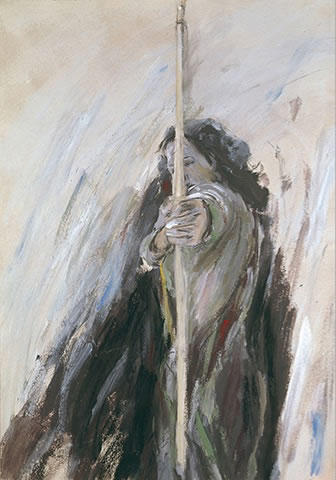
»Frauen XXX«, 1976, Acrylic and pastel crayon on cardboard, 100 x 70 cm
© Bignia Corradini und VG Bild-Kunst Bonn, 2018 / Foto: Jochen Littkemann, Berlin
It was not an abrupt switch, but a fluid transition, that took place in 1979, over the course of just a single year. The comparison between the portraits of women, such as Sich ausziehen II (fig.) and the non-figurative works, including Geburt (fig.), of the same year show that the two not only—what a gamble— share the large format, but also that Bignia Corradini carried over form and colour elements, as well as structures of movement, from one to the other. It was specifically these late figure paintings that led her to colour, the artist states. The colouring is still comparatively restrained, limited to individual shades of blue, yellow, or pink amidst the predominant white. But this can be understood as advance notice of the growing awareness of colour that, as of the 1980s, was articulated in an almost explosive manner. As far as the form elements are concerned, in the works of the year 1979 a particular incisiveness dominates, something splintered or sharp-edged, an increase in obstructiveness, which is expressed in the non-figurative works.
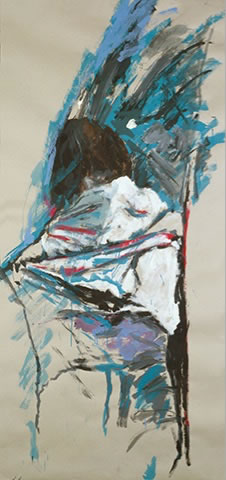
»Sich ausziehen II«, 1979, Acrylic on paper, 213 x 100cm
© Bignia Corradini und VG Bild-Kunst Bonn, 2022 / Foto: Jochen Littkemann, Berlin

»Geburt«, 1979, Acrylic on nettle, 250 x 150cm
© Bignia Corradini und VG Bild-Kunst Bonn, 2022 / Foto: Lepkowski, Studios Berlin
In 1980, however, during a six-month stay in New York, a retreat first took place: a turning away from colour towards pure black and white, and a switch from the large format to works on paper as well as from individual pictures to cycles of works. It was the search for a not yet tangible form that made Bignia Corradini return to this occupation again and again. ‘Open myself up to the unknown. Arrive somewhere I never remotely imagined I would ever arrive at’, as she recorded in a journal-like way in the catalogue for Sterne sehen – Flecken, schwarz und weiß. And elsewhere she spoke, almost with dismay, of what to her is an inexplicable obsession: ‘I cannot allow it, and I hate black and white. I want to go to the light. Colour and light.’ The fact that this intensive occupation with form—which occurred more unwillingly than intentionally—would have a direct effect on the coming work was not yet completely clear to her at the time, even though she gave these works the name Übungen für die Bilder.
In 1982, she exhibited the works on paper created in New York with the title Blätter wie Töne, Noten, Musik. Ein Alphabet at the Galerie Jörg Stummer in Zurich (fig.). As a result of how the works, seven hundred in total, were staged in the rooms of the exhibition, it was possible to almost physically experience how a structure took shape from form to form that gradually revealed a picture of a whole simply in the sense of individual ‘tones’ or ‘signs’.
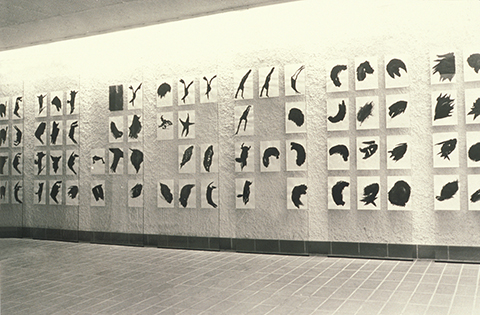
»Sterne sehen – Flecken, schwarz und weiß«, 1982,
An installation with 700 »Stains«, Acrylic on paper in A4 format, Galery Jörg Stummer, Zurich
As if this restriction to black and white brought about the awakening of colour, it appeared, starting in the 1980s, as a means of expression on an equal footing—the one unthinkable without the other. In the forms triggered by the cycle of drawings, assembled to create flying formations, at the beginning the shades of red, blue, and yellow mostly dominated, standing out from the white, black, or coloured pictorial grounds. With the expansion of her colour scale in the mid-1980s, Bignia Corradini left behind the figure-on-ground principle; the form and colour harmonies were extended over the entire square of the canvas, and they grew, ever more intensively, to become an energized staccato. Spot, fragment, and splintered form—from maize yellow to light green, turquoise, orange, blood red, brown, grey, to white and black, in a constant contrast between cold and warm, dark and light—collide in concentrated whirls.Wirbelfetzer, Chance, Schwindel II are some of the titles given by the artist—incidentally, always in retrospect (figs.). But what are they supposed to mean? They function still today as a kind of ‘receiver’ in that the wording or sound of the words conjures up an echo of life, reminiscences of things seen, read, heard, tasted, as they continuously permeate the thoughts and pictorial world of the artist.

»Schwindel II«, 1984, Acrylic on canvas, 230 x 170cm
© Bignia Corradini und VG Bild-Kunst Bonn, 2022 / Foto: Jochen Littkemann, Berlin

»Chance«, 1984, Acrylic on canvas, 170 x 230cm
© Bignia Corradini und VG Bild-Kunst Bonn, 2022 / Foto: Jochen Littkemann, Berlin
In 1988, once again during a stay in New York, another concentrated occupation with works on paper occurred, this time within the framework of an encounter with the culture of Islam. In New York, Bignia Corradini had come across a collection of pattern books for Islamic ornamentation, which inspired her to examine both her own Western-influenced view of art and the traditional Islamic outlook. Das Übermalen von Musterbüchern consists of eighty sheets on which the contrast between her own and the foreign is formulated in various modalities. Many works play with the Islamic black-and-white lines based on mathematical principles by crossing them over with polyphonic polylines, to then, on other sheets, emphasize the formal contrasts by means of a gestural trace of overpainting. At the same time, portions of the pattern are always left blank in such a way that a dialogical encounter develops between the two means of expression. (figs.). Das Übermalen von Musterbüchern consists of eighty sheets on which the contrast between her own and the foreign is formulated in various modalities. Many works play with the Islamic black-and-white lines based on mathematical principles by crossing them over with polyphonic polylines, to then, on other sheets, emphasize the formal contrasts by means of a gestural trace of overpainting. At the same time, portions of the pattern are always left blank in such a way that a dialogical encounter develops between the two means of expression. (figs.).

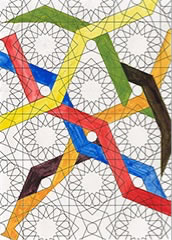
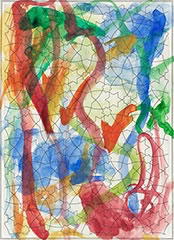
»Das Übermalen der Musterbücher«, 23 x 18 cm

»Das Übermalen der Musterbücher«, Galerie Adrian Bleisch, Arbon, 2003
© Bignia Corradini und VG Bild-Kunst Bonn, 2022 / Foto: Guido Kasper, Konstanz
This second cycle, just as the previous one of 1980, also left behind traces in her painting on canvas. Years later, starting in 2008, Bignia Corradini began to transfer ornamental structures of this sort — as, for instance, evident inHCSIBARA and XIW – to the pictures on canvas (figs.).

»HCSIBARA«, 2008, Acrylic on canvas, ∅ 120cm
© Bignia Corradini und VG Bild-Kunst Bonn, 2022 / Foto: Lepkowski Studios, Berlin

»XIW«, 2008, Acrylic on canvas, 100 x 100 cm
© Bignia Corradini und VG Bild-Kunst Bonn, 2022 / Foto: Lepkowski Studios, Berlin
In 1992, four years later, Bignia Corradini began a further shift in painting with the painted wall-objects, the Quader. Her idea was to extend the painted structure captured up to then on the square paintings from the surface into the third dimension, into real space. The painted structure consequently did not, for instance, stop on the front side of the objects, but continued on all sides of their edges and corners. The shift in perspective that the artist generated by doing so augments the way the objects can be presented many times over (fig.). They are, therefore, exhibited individually only as an exception, but are generally brought together in a ‘swarm’ that extends over the entire surface of the wall up to the ceiling. As could be experienced in the exhibition of the seven hundred works on paper in 1980, this form of presentation requires full flexibility with respect to viewing angle. If we would like to grasp the paths of movement that extend over all the sides of the Quader themselves, just as those that span between the objects as a whole, this cannot occur from one single standing position, but only and solely by us—in correspondence with their particular nature—moving through the space ourselves.
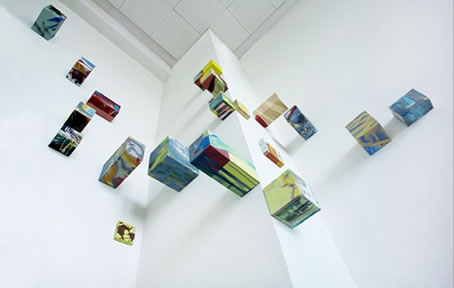
»Quader Prismen und Zylinder«, Galerie Adrian Bleisch, Arbon, 2003
© Bignia Corradini und VG Bild-Kunst Bonn, 2022 / Foto: Stefan Rohner, St. Gallen
Since that year, the occupation with the picture object—today numbering around four hundred—has been appended seamlessly to the examination of the picture on canvas. As much as perception at first differentiates one from the other—here the picture surface, there the picture corpus; here the individual picture, there the swarm—they are very closely related to one another with respect to the form of expression. When, around the mid-1990s, Bignia Corradini’s painting began to shift again, this was manifested in both media at the same time. Whirl and ball were gradually extended to include explorative bands of colour; movement and countermovement—the primary source of Bignia Corradini’s painting—collide with and overlay one another, one time flowingly, one time hesitantly, in broadly applied brushwork (fig.). And this will, as the further development until 2018 shows, bring further shifts, concentrations, and interweavings along with it.

»Ort der mögichen Verschiebungen«, 1997, Acrylic on canvas, 140 x 170cm
© Bignia Corradini und VG Bild-Kunst Bonn, 2022 / Foto: Jochen Littkemann, Berlin
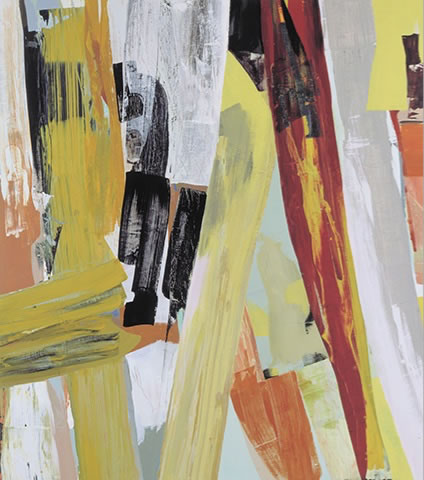
»Regellos und Abweichung«, 1993, Acrylic on canvas, 170 x 150cm
© Bignia Corradini und VG Bild-Kunst Bonn, 2022 / Foto: Jochen Littkemann, Berlin
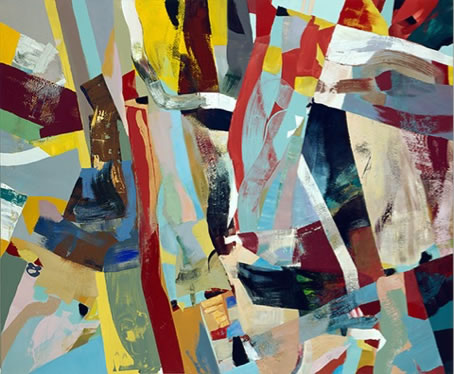
»Zusammenschluss I«, 1998, Acrylic on canvas, 170 x 150 cm
© Bignia Corradini und VG Bild-Kunst Bonn, 2022 / Foto: Jochen Littkemann, Berlin
Standstill? It does not exist in Bignia Corradini’s oeuvre. Whether in the original definition or extended up to peripheral zones, painting, the ‘how’ and the ‘what’, is orbited in large arcs. Since the 1970s, this is what has led Bignia Corradini to focus again and again on rediscovering painting anew.
August 2018
© Elisabeth Grossmann, Aarau
in: ›Bignia Corradini: Malerei I Painting 2000 – 2018‹
KERBER VERLAG, gebundene Ausgabe: 232 Seiten, 2018, 174 Farbabbildungen.
Elisabeth Grossmann, born 1947 in Basel (CH). Studied art history, cultural anthropology, and ethnology in Basel, Munich, and Zurich. Following work at various institutions (including the Swiss Institute of Art History, Zurich; the Museum of Design, Zurich; the Fondation Le Corbusier, Paris), she was appointed director of the Kunstmuseum des Kantons Thurgau, Kartause Ittingen, Warth; the Museum Haus Konstruktiv, Zurich; and the Museum Kunst(Zeug)Haus, Rapperswil-Jona. She is the author of numerous publications, primarily about art in Switzerland
